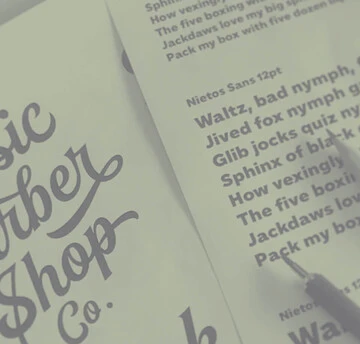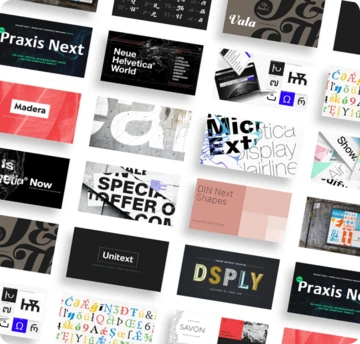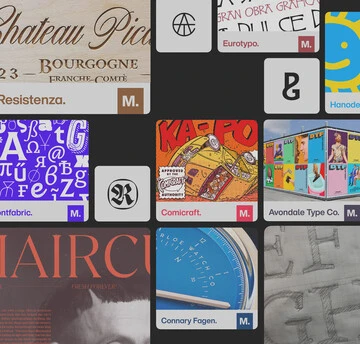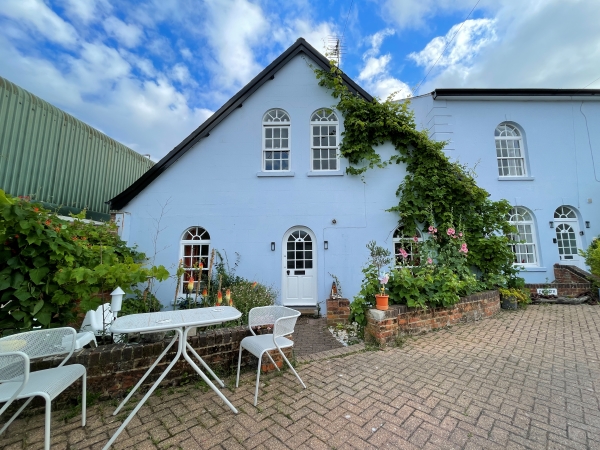Type Faces: Meet Spike Spondike.
Spotlights

Spotlights
Type Faces: Meet Spike Spondike.
Welcome to our Type Faces series, where we’ll be sharing the stories of some of the fabulous people behind the type here at Monotype. From all around the globe and across the organization, our Monotype colleagues truly prove that, like Charles Nix, Senior Executive Creative Director at Monotype, always says, “We are ALL creative.”
Spike Spondike is a musician, shipping container enthusiast, and all-around creative soul. Spike’s unique career path in design ultimately lead to her current role as Senior Type Designer at Monotype by way of Colophon Foundry, acquired by Monotype in 2023. Read on to learn more about Spike.
Portrait of Spike Spondike.
You’ve lived in England for almost 20 years, and currently live on the Isle of Wight. What do you love about where you live?
My partner and I were looking for a house to buy in Hastings. During the search, we visited a friend who was living on the Isle of Wight and he really convinced us to move here. It’s not convenient by any means — it’s a trek to catch a plane, for example — but I like the separation.
The fact that you have to take a ferry to get here means that all visits are very intentional. I miss London sometimes, but it’s very peaceful here on the water, and I’m close to the Southampton port, where I can see all the ships and their shipping containers coming in and out.
The White Shipyard in East Cowes is just down the road from Spike’s home. Note the container ship near the horizon line.
I also really love our house. I’m a homebody, so home is really important to me. And I think I would love this home no matter where in the world it was located. It’s not traditional — it’s an old schoolhouse from the 1850s that’s part of a church complex of five buildings. It has an open floor plan and tons of character. It’s perfect for entertaining guests!
Spike Spondike’s house was built in 1829 and is a Grade II listed home, a designation for buildings of special architectural or historic interest.
Home is important to you — what about family? What can you tell me about your heritage?
My mother’s grandmother left her home in Hungary and made the journey to the United States when she was 16. I have fond memories of her, especially of her house. It smelled amazing! I wouldn’t say that our Hungarian background was very strong, but it was always there. Back then, immigrants were focused on assimilating, so they focused on speaking English and being American in the home.
Still, my mom was always interested in writing to and connecting with that part of the family. She started writing to a relative in Hungary when I was young, and then I began writing to my cousins. We would send them gifts, very American things — like Levi’s with the tags cut off. It was quite a nice back and forth relationship for a long time. In fact, I traveled to visit my cousins about ten years ago.
Spike and her partner, Krysia, with her great-grandmother’s village, Szentpál, in the background.
Tell me about that trip! Where did you go?
My partner and I first met up with my cousin Béla and wife, Zita, in Budapest in 2014 along with my brother and his husband. Then in 2015, my partner and I took a two-week trip to Transylvania, to the town where my great-grandmother was from — Szentpál. It’s a beautiful place in the heart of the Carpathian Mountains.
Béla also took me to meet his mother and grandmother. Their home smelled exactly like my great-grandmother’s! Doing a trip like this that’s all about your family ancestry is really interesting. It was emotional for me because my mother was never able to make that trip herself, though she was able to live through my experience and was touched by it. She passed in 2021, so this family connection and continuing that heritage is important to me.
Spike visiting with her second cousins Béla and Csilla in Transylvania with their mother, grandmother, and Csilla’s daughter. Spike wrote with these cousins in the late 1980s.
Do you have a favorite family recipe?
Yes! My great-grandmother’s recipe for Hungarian chicken paprikash. I don’t make it nearly enough, though my nephew makes it quite often. In Budapest the first time around, along with our second trip to Transylvania, we ordered chicken paprikash in every restaurant to compare them all to each other.
View from the deck of a GENCA cargo ship.
You mentioned watching shipping containers coming in and out of port. What about them interests you?
I got into shipping containers after I moved here. I just love industrial spaces and Brutalist architecture, and shipping containers are like these crazy colorful, pixelated boxes out on the sea. They’re just amazing to see and I love watching the logistics of moving them, all the big cranes and everything.
View from Spike’s cabin window aboard the GENCA cargo ship while the ship was being loaded.
When I found out that you can actually book travel on these ships, a friend and I booked a cruise from Antwerp, Belgium to Hanko and Rauma, Finland through the Baltic and North Seas on a 200+ meter ship. It was incredible to see how they operate, especially how they load and unload their cargo. It was a truly unforgettable experience and I hope to do it again soon.
View of the GENCA cargo ship crew spraying down the containers from the deck.
Are there any other objects that inspire you?
There are many objects that inspire me. I get a kick out of vintage hi-fi equipment and other vintage electronics, especially all their modules, colors, and knobs. I also collect vintage Casio calculator watches and clocks. I just love the numbers and the nostalgia.
Spike’s Casio watch collection.
Besides your work in type, how else are you creative?
Music has always been in the background of my creative life. I’ve been DJing for about 24 years; I find the repetition in electronic music to be meditative. I’m in an experimental synth duo with my partner called Egg with Egg. We make noise, record it, and put it on SoundCloud.
DJ Snacks in action. Listen to some of DJ Snacks’ mixes here.
What’s something that would surprise people about you?
I’m actually an introvert. I always prefer to be behind the camera, behind the DJ booth, or making the cocktails instead of socializing at a party.
Venus de Meow Meow, Spike and Krysia’s cat, sitting in her favorite place, on top of a warm amplifier. Next to her is a vintage Telequipment Oscilloscope S51E (1979), featured as a prop in the opening scene of the iconic film Back to the Future. Spike likes to use it as a fun visual when playing music.
What connections do you see between your creative pursuits and typography?
There are so many. First, the shipping containers — there’s so much lettering to see, lots of stencils and signs that look like melted metal because they’re made with welding tools.
Signage on the GENCA cargo ship.
And music — even before I knew anything about typography, when I was a kid making mixtapes, I’d always make the music covers myself with hand lettering. I’d think just as much about that artwork as I did the music; I’ve always seen a real connection between music and graphics. I really loved how Monotype’s 2024 Type Trends report used the idea of album covers as inspiration, because type and music are such an iconic combination.
Spike’s vintage Technics, rotary mixer, and vinyl collection.
You’ve talked about the power and impact of music and strong visuals in your life. One of the best places where music and art come together is in film. What’s your top movie recommendation?
My favorite movie right now is Riddle of Fire. I watched it on a plane while traveling, then watched it again when I got home. It was shot on 16mm film and just ticks all the boxes for me when it comes to an artistic look, the character development, and the storyline. I’m also a huge Wes Anderson fan. I’ve seen “The Fantastic Mr. Fox” more times than I can count!
The entrance hall to Spike’s home. Note the 1980s destination sign for East Cowes and working American traffic light.
How did you end up working in typography?
My career path has covered a lot of creative ground. I started in interior design after getting my undergrad degree in Cincinnati, Ohio. Then I moved to the West Coast, where my first design role was at a branding agency where I designed exhibition spaces and retail fixturing for footwear. That job helped me develop my personal design taste and my belief that all types of design tie together.
I moved to London in 2005 for a master’s course at Central Saint Martins called “Creative Practice for Narrative Environments.” This really tied all my interests into one, with collaborations between graphic designers, sound engineers, and poets all working together on a live project to tell stories. After that, I worked at Design Against Crime, where I was designing environments that would suppress opportunistic crimes like bike theft and pickpocketing.
Spike’s home office desk setup.
And it was after that that I applied for a job as a font hinter, which involves optimizing the display of digital fonts, with zero experience. I was hired on the spot during the interview and thrown into typeface design from day one. It was a massive learning curve!
Cosmo, Spike and Krysia’s rescue dog from Cyprus, sitting in the living room (a portion of the CD collection in the background).
Do you have a favorite font?
My favorite font is Cooper Black, especially italic. Mainly because of nostalgia — growing up in the 1970s in America, this font was everywhere. It’s so versatile! It’s the brand font for Tootsie Roll, it’s on X-rated adult movie posters, it’s used in the logo for easyJet … somehow you can slap it anywhere and it not only works, but it looks good. I don’t know if any other font can do that. I can only dream of designing a typeface that versatile!
Cooper Black spotted in the engine room of the GENCA cargo ship.
What’s the most exciting thing you’ve gotten to do at work?
Designing my first typeface, Blenny, three years into my type design career. It’s always exciting to spot it out in the wild. It was on Typographica’s list of favorite fonts of the year in 2014. It’s included in Adobe Photoshop tutorials and when I see it, I just feel like that’s so cool.
Spike’s typeface, Blenny, featured on notebooks, a book cover, and the backing for a pin.
What do you love about your job?
There are two things that stand out. One is more general: once you fall in love with letters, it’s hard to fall out of love with them. They’re everywhere and you can’t escape from it. You look at them and think, “I wish I would have done this,” or “I could have done that differently.” I love the black and white world, the positive and negative spaces of letters.
Curious metal signage on the GENCA cargo ship.
The other thing I love about my job is the people. I’m surrounded by talented people who are so incredibly supportive. I’m encouraged to discover more about myself and do things outside of my comfort zone, like giving talks. This is important because type design isn’t just about sitting behind a computer and designing letters.

Senior Typeface Designer
Spike Spondike.
Spike Spondike is an award-winning Senior Typeface Designer at Monotype. Her experience includes almost a decade working with Dalton Maag, and the past two years with Colophon Foundry. She has worked with global agencies designing typefaces for some of the biggest names we know.






























